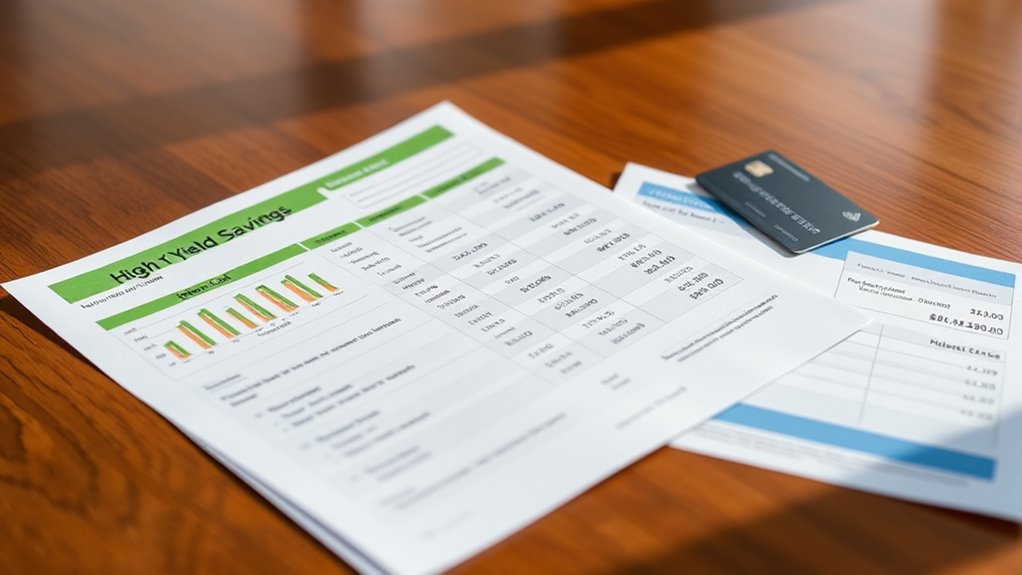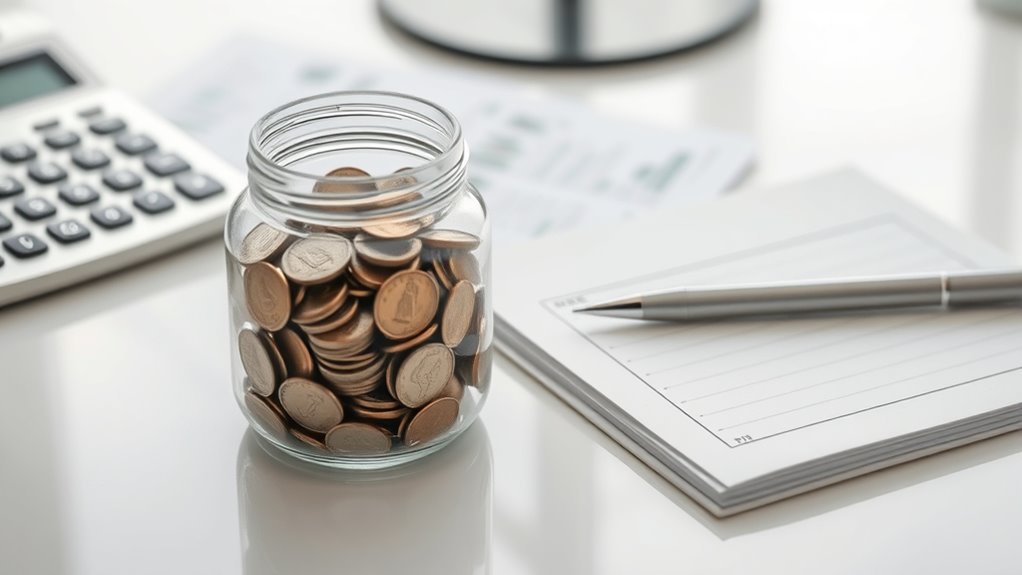Understanding the key differences between high-yield savings and checking accounts helps you manage your money better. A high-yield savings account earns more interest but limits your access to funds, making it ideal for savings goals. A checking account offers quick access for daily transactions but usually pays little or no interest. By weighing these pros and cons, you can choose the right mix for your financial needs—and discover how to optimize both accounts effectively.
Key Takeaways
- High-yield savings accounts offer higher interest rates and passive growth but limit withdrawal frequency, making them ideal for savings.
- Checking accounts provide easy, unlimited access to funds for daily transactions but typically offer little to no interest.
- Savings accounts focus on wealth accumulation through interest, while checking accounts prioritize accessibility for routine expenses.
- Combining both accounts allows for balancing high earning potential with convenient access to funds.
- Your choice depends on your financial habits: use savings for growth and checking for everyday spending.

When it comes to managing your finances, understanding the differences between high-yield savings accounts and checking accounts is essential. These accounts serve different purposes, and knowing how they work helps you make smarter financial decisions. One key aspect to contemplate is interest accrual. High-yield savings accounts are designed to earn you more interest than traditional savings or checking accounts. They typically offer higher annual percentage yields (APYs), allowing your money to grow faster over time. Money in these accounts accrues interest daily or monthly, so the more you keep in your high-yield savings, the better your earnings. However, this interest accrual is usually passive, meaning you don’t have to do anything to earn it. Instead, your bank calculates and adds interest periodically, helping your savings compound over time. Additionally, these accounts are often associated with specific Dog names that can make your savings experience more personalized and enjoyable.
Account accessibility is another major difference. Checking accounts are designed for everyday transactions, so they offer easy access to your funds through debit cards, ATMs, checks, and online transfers. You can withdraw or spend money as often as you like, making checking accounts highly liquid and user-friendly. On the other hand, high-yield savings accounts tend to restrict access to your funds. There might be limitations on the number of withdrawals or transfers you can make each month, often due to federal regulations or bank policies. This makes them less suitable for daily spending but ideal for building an emergency fund or saving toward a specific goal. The limited accessibility in high-yield savings accounts helps prevent impulsive spending and encourages saving discipline.
While checking accounts excel in convenience, they usually offer lower or no interest on your balances, meaning your money doesn’t grow much while sitting in the account. Conversely, high-yield savings accounts prioritize growth through interest accrual, but they sacrifice the quick, easy access you get with checking accounts. When choosing between the two, you should think about your financial habits. If you want frequent access to your money for bills and daily expenses, a checking account is your best bet. If you’re aiming to grow your savings with minimal temptation to spend it, a high-yield savings account might be more appropriate. Many people find that using both accounts in tandem offers the best of both worlds: easy access when needed and higher earnings on savings. Understanding these differences helps you optimize your finances effectively.
Frequently Asked Questions
Can I Convert a Checking Account Into a High-Yield Savings Account?
You can’t directly convert a checking account into a high-yield savings account. Instead, you’ll need to open a new high-yield savings account, as account conversion isn’t typically available. Verify the account eligibility requirements for the savings account before applying. Once approved, transfer funds from your checking account to your new high-yield savings account. This approach ensures you benefit from the higher interest rates without losing access to your funds.
Are There Withdrawal Limits on High-Yield Savings Accounts?
Think of your high-yield savings account as a guarded treasure chest. You’ll face withdrawal restrictions and transfer limitations, usually around six per month due to federal regulations like Regulation D. These limits help protect your savings’ growth but also mean you can’t access funds freely. So, plan your withdrawals carefully, knowing that while your money’s protected, your access is somewhat restricted, like a guarded treasure waiting to be opened.
Do High-Yield Savings Accounts Have Monthly Maintenance Fees?
High-yield savings accounts often don’t have monthly maintenance fees, which helps maximize your savings. However, some banks may charge account fees if you miss minimum balance requirements or for certain account services. While these accounts offer good account accessibility, it’s essential to review the fee policies to prevent unexpected charges. Keeping track of your account activity ensures you enjoy the benefits without incurring unnecessary fees.
How Do Interest Rates Vary Between Different Banks?
Think of interest rates like the tides—they fluctuate regularly. When you compare banks, you’ll see interest rate fluctuations vary widely, influenced by economic conditions and policies. Use bank comparison charts to spot these differences and find the best rates. Some banks offer higher yields to attract customers, while others keep rates lower. Staying informed helps you maximize your savings, ensuring you earn more as interest rates rise and fall.
Can I Use a High-Yield Savings Account for Daily Transactions?
You can use a high-yield savings account for daily transactions, but it’s not always practical. Most offer limited ATM access and mobile banking options, so withdrawing cash or making quick payments can be inconvenient. While some accounts provide ATM cards, frequent transactions might reduce your interest earnings. For daily expenses, a checking account is more suitable due to easier mobile banking access and unlimited transactions.
Conclusion
Imagine your money as a garden—you want some plants to grow quickly, like checking accounts for daily needs, and others to flourish silently, like high-yield savings for future dreams. By choosing the right balance, you nurture both immediate comfort and long-term security. So, take control, plant your funds wisely, and watch your financial landscape bloom—today, tomorrow, and beyond. Your financial future is yours to cultivate.









